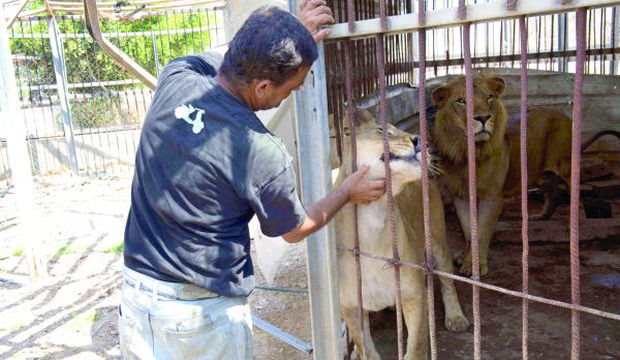
Farid Al-Hissi scratches the neck of the lioness from outside the cage housing her and a lion at the Bisan Zoo, in Beit Hanun in the Gaza Strip on August 14, 2014. (AFP Photo/Roberto Schmidt)
Gaza, Asharq Al-Awsat—Israeli airstrikes on Gaza’s zoos have killed most of the resident animals, and the remaining creatures are starving, sick or injured, say zookeepers in the enclave.
Bisan Amusement Park in northern Gaza, the largest zoo on the Strip, was among the targets of Israeli fighter jets, which turned the “green heaven,” as it was known to locals, into ashes.
In a statement to Asharq Al-Awsat, Shadi Hamad, the director of the Bisan park, said that the repair work to the zoo’s infrastructure was estimated to cost 100,000 US dollars. That estimate covers only the replacement of cages and equipment, however; the management also needs to cover the cost of repopulating the park with animals after many were killed in Israel’s Operation Protective Edge.
Hamad said the zoo used to be home to around 100 animals, including lions, ostriches, crocodiles and monkeys. Of this number, only 10 survived the Israeli onslaught, and most of those were sick, injured or severely malnourished.
During the first few days of the offensive, he said, Israeli drones fired two missiles on the zookeepers while they were trying to evacuate the park, forcing them to flee.
Zookeeper Mahmoud Al-Halabi told Asharq Al-Awsat the surviving animals include one baboon, three lions—one of which is injured—ostriches, and a few other smaller animals.
Halabi said all the animals were brought into Gaza through the commercial tunnels dug under the Egyptian border.
The zoo is part of a larger recreational area measuring including farmland, plantations, swimming pools and cafeterias. Large areas were completely devastated as a result of shelling.
Halabi estimated that “70 percent of the park was destroyed by nearly eight missiles fired by F-16 fighter jets.”
He confirmed that the reconstruction of the park would be carried out once a lasting ceasefire agreement was reached and that the administrators would try their best to bring in new animals. He conceded that this would be extremely difficult as the tunnels used to smuggle the animals in have been closed.
The Southern Woods Zoo in Khan Younis in southern Gaza was also targeted during the Israeli offensive.
Ziyad Oweida, the park’s manager, told Asharq Al-Awsat he had personally arranged to have all the animals brought into Gaza after he met with dealers from Senegal, Sudan and other African countries. The animals were transported through the smuggling tunnels.
He said the zoo’s initial construction had cost an estimated 1 million dollars. The cost of bringing in three tigers was nearly 60,000 dollars, and a couple of lions came in at 30,000 dollars.
He said the park had sustained considerable damage in the Israeli bombardment of the Strip. He believed more than 50 percent of the animals had died as a result of direct Israeli shelling.
“Israel does not know what it wants. It only targets us as Palestinians and it has no specific targets,” he said. “It claims that it only kills and strikes resistance targets. But as you can see, there is nothing related to resistance here. Here we have only some animals and a small park. It is the occupation forces that keep searching for pretexts to justify their assaults against Gaza residents.”
Oweida said he hoped to rebuild his dream of keeping a zoo in Gaza.
